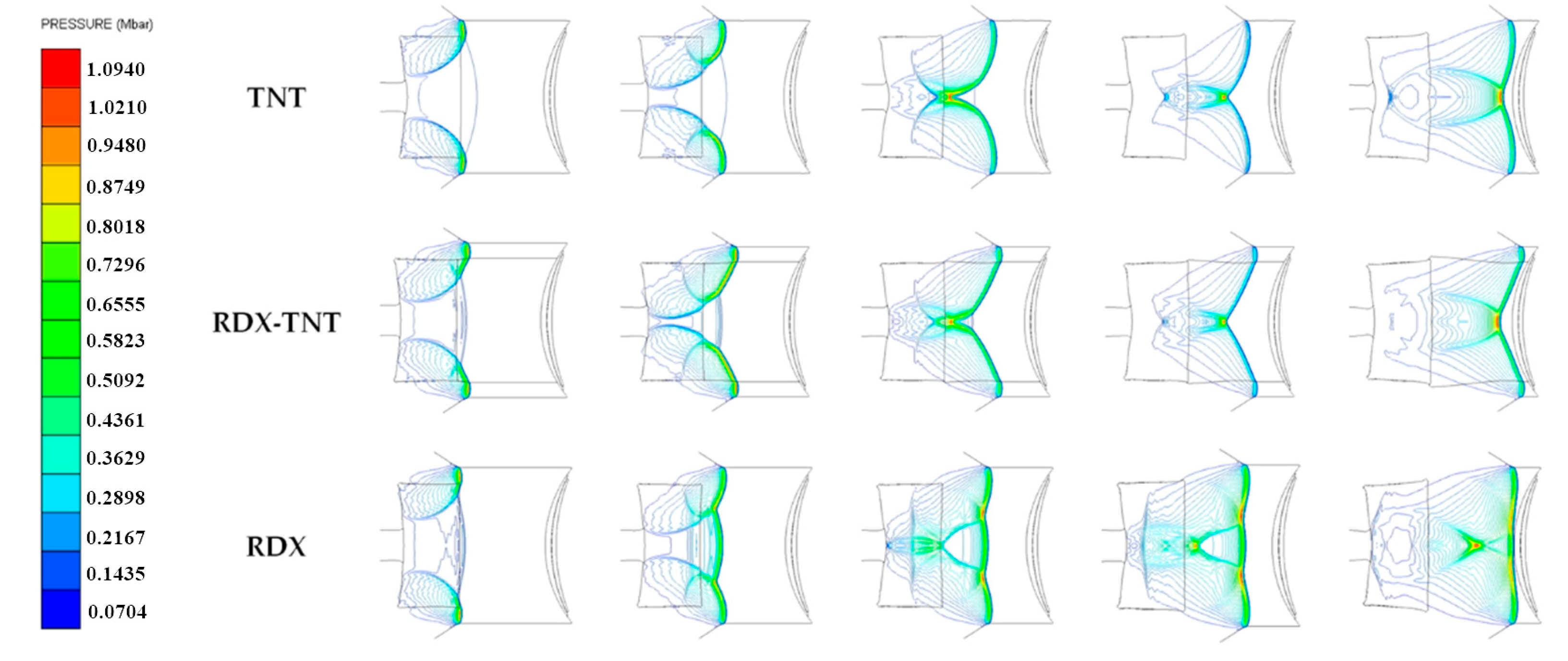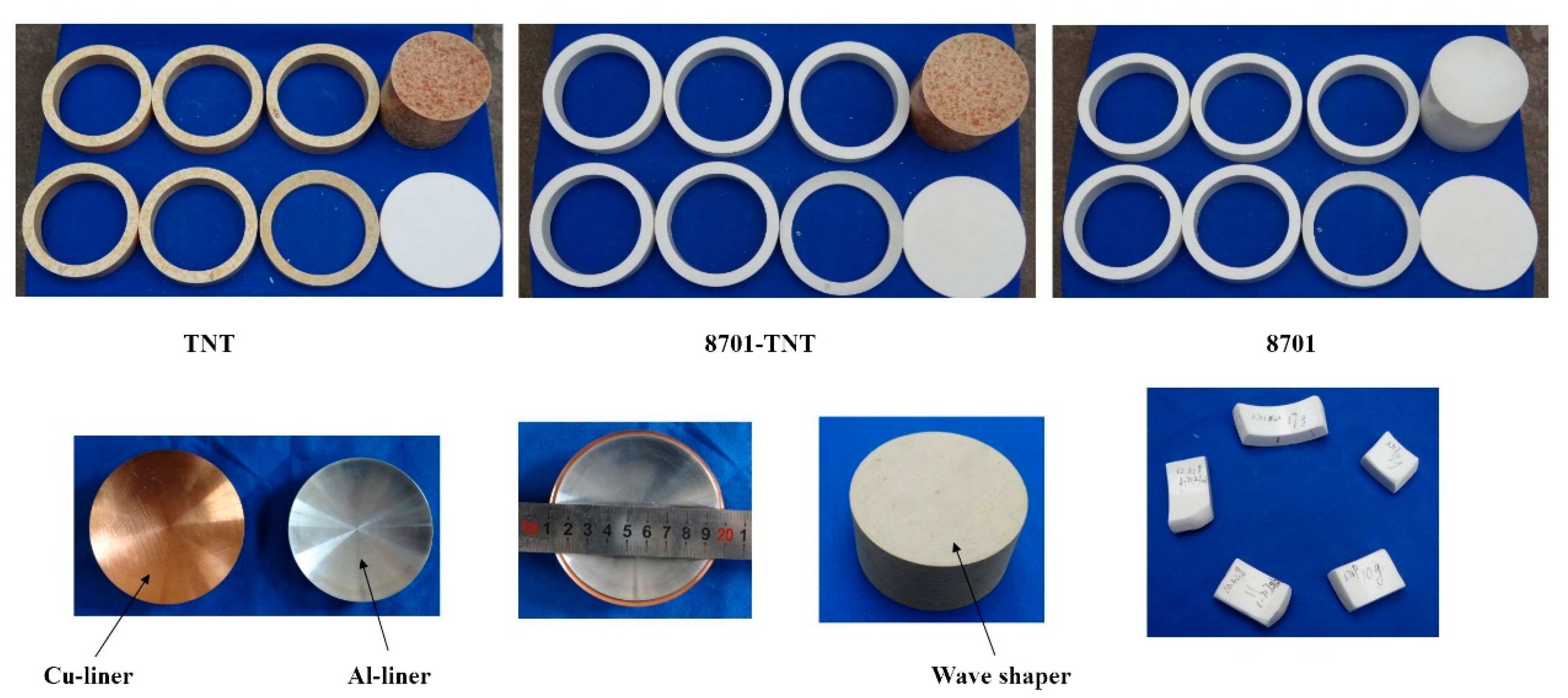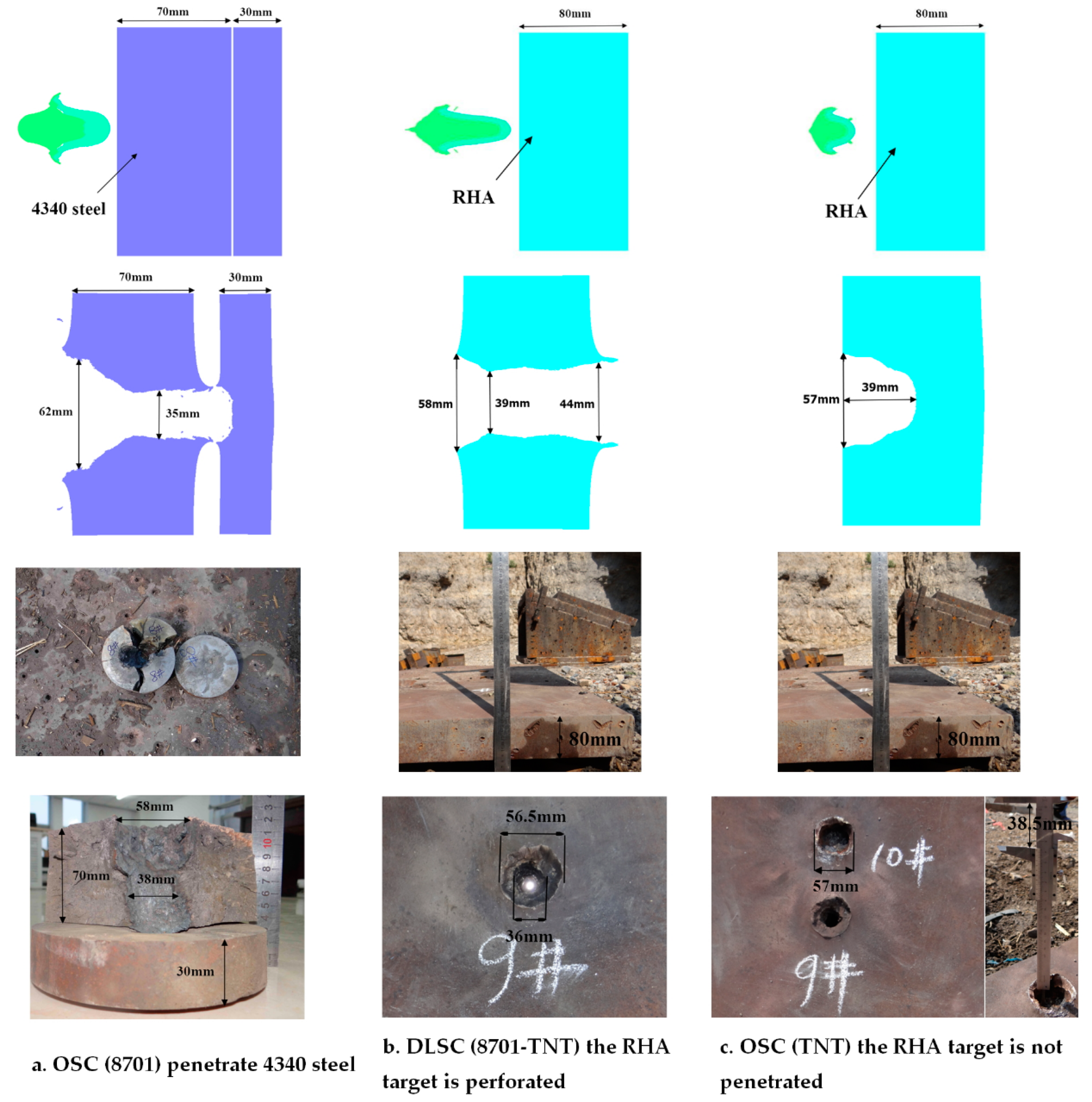The EFP Formation and Penetration Capability of Double-Layer Shaped Charge with Wave Shaper
Abstract
1. Introduction
2. Detonation Wave Propagation Path in DLSC
3. Numerical Simulation
EFP Forming Process in OSC and DLSC
4. Experimental Verification and Discussion
5. Conclusions
- (1)
- In DLSCs, because of the differences in detonation velocity between the two explosives, horn waves can be formed inside the charge regardless of the performance of wave shapers. Detonation waveforms can be optimized and form overdriven detonation at the charge axis, and then a long rod EFP with a large length-diameter ratio is obtained.
- (2)
- We designed three kinds of shaped charges to experiment with and verify the penetration capability of EFP, and they are OSC (8701), DLSC (8701-TNT), and OSC (TNT), respectively. The results show that the penetration capability of a long rod EFP with a large length-diameter ratio obtained by the DLSC (8701-TNT) is the best, and the penetration depth is increased by at least 107.8% compared with the OSC (TNT). DLSCs can optimize the detonation waveform to obtain EFPs with a better aerodynamic shape, which improves the penetration capability of EFPs for long-distance armored targets. The research results can provide a reference for the application of the DLSC in engineering and a new idea for the structure design of small-caliber terminal sensitive projectile.
Author Contributions
Funding
Conflicts of Interest
Abbreviations
| DLSC | Double-layer shaped charge |
| OSC | Ordinary shaped charge |
| EFP | Explosively formed projectiles |
| HE | High-detonation-velocity explosive |
| LE | Low-detonation-velocity explosive |
| SCWS | Shaped charge with wave shaper |
References
- Zhang, X.F.; Huang, Z.X.; Qiao, L. Detonation wave propagation in double-layer cylindrical high explosive charges. Propellants Explos. Pyrotech. 2011, 36, 210–218. [Google Scholar] [CrossRef]
- Liu, Y.K.; Yin, J.P.; Wang, Z.J. Study on overdriven detonation of double-layer shaped charge. Propellants Explos. Pyrotech. 2019, 44, 1–14. [Google Scholar] [CrossRef]
- Li, W.B.; Wang, X.M.; Li, W.B. The effect of annular multi-point initiation on the formation and penetration of an explosively formed penetrator. Int. J. Impact Eng. 2010, 37, 414–424. [Google Scholar] [CrossRef]
- Li, W.B.; Wang, X.M.; Li, W.B. Research on the optimum length-diameter ratio of the charge of a multimode warhead. Shock Waves 2012, 22, 265–274. [Google Scholar] [CrossRef]
- Weimann, K. Research and development in the area of explosively formed projectiles charge technology. Propellants Explos. Pyrotech. 1993, 18, 294–298. [Google Scholar] [CrossRef]
- Zhu, C.S.; Huang, Z.X.; Zu, X.D. Mach wave control in explosively formed projectile warhead. Propellants Explos. Pyrotech. 2014, 39, 1–8. [Google Scholar] [CrossRef]
- Yi, J.Y.; Wang, Z.J.; Yin, J.P. Simulation study on expansive jet formation characteristics of polymer liner. Materials 2019, 12, 744. [Google Scholar] [CrossRef]
- Ma, G.S.; He, G.L.; Liu, Y.K. Study of the forming characteristics of small-caliber ammunition with circumferential MEFP. Materials 2020, 13, 891. [Google Scholar] [CrossRef]
- Ding, L.L.; Tang, W.H.; Ran, X.W. Simulation study on jet formability and damage characteristics of a low-density material liner. Materials 2018, 11, 72. [Google Scholar] [CrossRef]
- Liang, Z.G.; Chen, B.X.; Nan, Y.X. Research on the computing method for the forming velocity of circumferential multiple explosive formed projectiles. J. Def. Model. Simul. Appl. Methodol. Technol. 2019, 17, 1–12. [Google Scholar] [CrossRef]
- Yin, J.P.; Han, Y.Y.; Wang, X.F. A new charge structure based on computer modeling and simulation analysis. J. Vis. Commun. Image R. 2019, 64, 102613. [Google Scholar] [CrossRef]
- Cui, Z.L.; Xu, H.M.; Jing, L.W. Experimental and numerical investigation of blasting height effect on penetration properties. Blasting 2016, 33, 39–44. [Google Scholar]
- Cardoso, D.; Teixeira, F. Modeling the formation of Explosively Formed Projectiles (EFP). Int. J. Impact Eng. 2016, 93, 116–127. [Google Scholar] [CrossRef]
- Liu, J.F.; Long, Y.; Ji, C. Theoretical and experimental study on performance parameters of double layer liners EFP warhead base d on grey system theory. Chin. J. Energ. Mater. 2016, 8, 728–734. [Google Scholar]
- Wang, H.F.; Guo, H.G.; Geng, B.Q. Application of PTFE/Al reactive materials for double-layered liner shaped charge. Materials 2019, 12, 2768. [Google Scholar] [CrossRef] [PubMed]
- Guo, H.G.; Xie, J.W.; Wang, H.F. Penetration behavior of high-density reactive material liner shaped charge. Materials 2019, 12, 3486. [Google Scholar] [CrossRef] [PubMed]
- Zhang, Z.M.; Xu, B.Y.; Yan, F. Penetrating test of active metal charge liner perforating bullet. Explos. Mater. 2013, 42, 53–56. [Google Scholar]
- Cui, P.; Wang, D.; Shi, D. Investigation of penetration performance of Zr-based amorphous alloy liner compared with copper. Materials 2020, 13, 912. [Google Scholar] [CrossRef]
- Müller, F. Mach—Reflection of detonation waves in condensed high explosives. Propellants Explos. Pyrotech. 1978, 3, 115–118. [Google Scholar] [CrossRef]
- Dunne, B. Mach reflection of detonation waves in condensed high explosives. Phys. Fluids 1961, 4, 981. [Google Scholar] [CrossRef]
- Dunne, B. Mach reflection of detonation waves in condensed high explosives II. Phys. Fluids 1964, 7, 1707. [Google Scholar] [CrossRef]
- Pan, J.; Zhang, X.; He, Y. Theoretical and experimental study on detonation wave propagation in cylindrical high explosive charges with a wave-shaper. Cent. Eur. J. Energ. Mater. 2016, 13, 658–676. [Google Scholar] [CrossRef]
- Lu, L.; Pan, J.; Li, G. Recyclable high-performance epoxy based on transesterification reaction. J. Mater. Chem. A 2017, 5, 21505–21513. [Google Scholar] [CrossRef]
- Held, M. Behavior of dual composition explosives. In Proceedings of the 6th International Congress of Pyrotechnics (ICP ’6), Tours, France, 6–8 June 1995; pp. 185–191. [Google Scholar]
- Zhang, X.F.; Qiao, L. Studies on jet formation and penetration for a double-layer shaped charge. Combust. Explos. Shock Waves 2011, 47, 241–248. [Google Scholar] [CrossRef]
- Wang, Z.; Jiang, J.W.; Wang, S.Y. Jet formation and peetration study of double-layer shaped charge. J. Energ. Mater. 2017, 36, 152–168. [Google Scholar] [CrossRef]
- Liu, Y.K.; Yin, J.P.; Wang, Z.J. Study on the overdriven detonation wave propagation in double-layer shaped charge. Phys. Fluids 2019, 31, 092110. [Google Scholar]
- Skrzypkowski, K.; Korzeniowski, W.; Sciubba, E. Adjustment of the yielding system of mechanical rock bolts for room and pillar mining method in stratified rock mass. Energies 2020, 13, 2082. [Google Scholar] [CrossRef]
- Lee, E.L.; Tarver, C.M. Phenomenological model of shock initiation in heterogeneous explosives. Phys. Fluids 1980, 23, 2362. [Google Scholar] [CrossRef]
- Souers, P.C.; Garza, R.; Vitello, P. Ignition & Growth and JWL++ detonation models in coarse zones. Propellants Explos. Pyrotech. 2002, 27, 62. [Google Scholar]
- Xu, W.L.; Wang, C.; Chen, D.P. Formation of a bore-center annular shaped charge and its penetration into steel targets. Int. J. Impact Eng. 2019, 127, 122–134. [Google Scholar] [CrossRef]








| Parameters | Unreacted Explosive | Detonation Products | ||||||
|---|---|---|---|---|---|---|---|---|
| Explosive | TNT | PBX | RDX | COMP-B | TNT | PBX | RDX | COMP-B |
| 1.63 | 1.842 | 1.836 | 1.717 | - | - | - | ||
| - | - | - | - | 6930 | 8800 | 8239 | 7980 | |
| - | - | - | - | 21 | 37 | 32.5 | 29.5 | |
| 1798 | 9.52 × 105 | 2.01 × 105 | 7.78 × 104 | 371.2 | 852.4 | 801.8 | 542.2 | |
| ) | −93.1 | −5.94 | −5.2 | −5.0 | 3.23 | 18.02 | 52.64 | 7.67 |
| 6.2 | 14.1 | 12.4 | 11.3 | 4.15 | 4.6 | 5 | 4.2 | |
| 3.1 | 1.41 | 1.24 | 1.13 | 0.95 | 1.3 | 2.1 | 1.1 | |
| 0.8926 | 0.8867 | 0.8867 | 0.8938 | 0.3 | 0.38 | 0.34 | 0.34 | |
| 7.0 | 10.2 | 8.5 | 8.1 | - | - | - | - | |
| Parameters | TNT | PBX | RDX | COMP-B | Parameters | TNT | PBX | RDX | COMP-B |
|---|---|---|---|---|---|---|---|---|---|
| 50 | 0 | 14 | 44 | 0 | 0 | 0 | 0.667 | ||
| 0.667 | 0.667 | 0.667 | 0.667 | 0 | 3.2 | 0 | 2 | ||
| 0 | 0 | 0 | 0.01 | 40 | 24 | 40 | 0 | ||
| 4 | 0 | 4 | 4 | 0.222 | 1 | 0.222 | 0 | ||
| 0 | 1899 | 488 | 414 | 0.666 | 1 | 0.666 | 0 | ||
| 0.667 | 1 | 0.667 | 0.222 | 1.2 | 1 | 1.2 | 0 |
| Materials | |||||||||
|---|---|---|---|---|---|---|---|---|---|
| Copper | 8.96 | 2.00 | 46 | 0.09 | 0.292 | 0.31 | 0.025 | 1.09 | 1356 |
| Aluminum | 2.70 | 1.97 | 27.1 | 0.04 | 0.48 | 0.27 | 0.01 | 1.00 | 1220 |
| 4340 Steel | 7.83 | 2.17 | 81.8 | 0.792 | 0.51 | 0.26 | 0.014 | 1.03 | 1793 |
© 2020 by the authors. Licensee MDPI, Basel, Switzerland. This article is an open access article distributed under the terms and conditions of the Creative Commons Attribution (CC BY) license (http://creativecommons.org/licenses/by/4.0/).
Share and Cite
Liu, Y.; Yin, J.; Wang, Z.; Zhang, X.; Bi, G. The EFP Formation and Penetration Capability of Double-Layer Shaped Charge with Wave Shaper. Materials 2020, 13, 4519. https://doi.org/10.3390/ma13204519
Liu Y, Yin J, Wang Z, Zhang X, Bi G. The EFP Formation and Penetration Capability of Double-Layer Shaped Charge with Wave Shaper. Materials. 2020; 13(20):4519. https://doi.org/10.3390/ma13204519
Chicago/Turabian StyleLiu, Yakun, Jianping Yin, Zhijun Wang, Xuepeng Zhang, and Guangjian Bi. 2020. "The EFP Formation and Penetration Capability of Double-Layer Shaped Charge with Wave Shaper" Materials 13, no. 20: 4519. https://doi.org/10.3390/ma13204519
APA StyleLiu, Y., Yin, J., Wang, Z., Zhang, X., & Bi, G. (2020). The EFP Formation and Penetration Capability of Double-Layer Shaped Charge with Wave Shaper. Materials, 13(20), 4519. https://doi.org/10.3390/ma13204519






